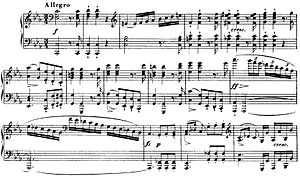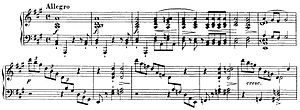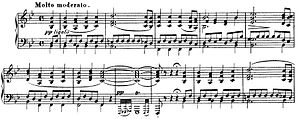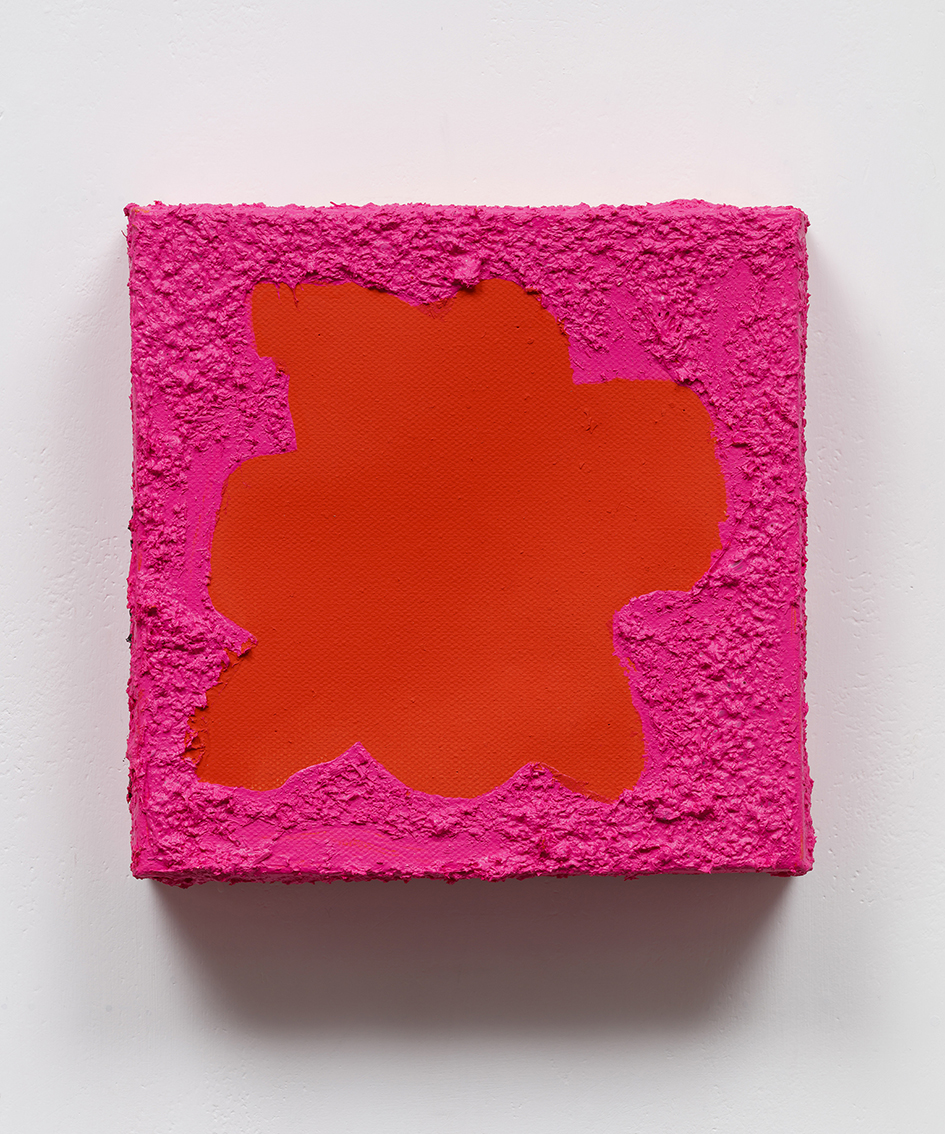●★ F. Schubert : Piano Sonata n.21 in Bb
D.960 - Alfred Brendel(Piano) ★●
●
Molto moderato
●
Andante sostenuto
●
Scherzo:Allegro vivace
●
Allegro ma non troppo
■ F. Schubert's last
sonatas ■
Franz Schubert's last
three piano sonatas, numbered
958, 959 and 960 in Deutsch's catalogue
of Schubert's complete works, are the composer's last major compositions for the
piano. They were
written during the last months of Schubert's life, between the spring and autumn
of 1828, but were not published until about ten years after his death, in
1838–39.[1]
Like the rest of Schubert’s piano sonatas, they were mostly neglected in the
19th century.[2]
By the late 20th century, however, public and critical opinion had changed, and
Schubert's last sonatas are now considered amongst the most important of the
composer's mature masterpieces. They are part of the core piano repertoire,
appearing regularly on concert programs and recordings.[3]
One of the reasons for the long period of neglect of Schubert's piano sonatas
seems to be their dismissal as structurally and dramatically inferior to the
sonatas of Beethoven.[4]
In fact, the last sonatas contain distinct allusions and similarities to works
by Beethoven, a composer Schubert venerated.[5]
However, musicological analysis has
shown that they maintain a mature, individual style. Schubert's last sonatas are
now praised for their mature style, manifested in unique features such as a
cyclical formal and tonal design, chamber music textures, and a rare depth of
emotional expression.[6]
The three sonatas are cyclically interconnected by
diverse structural, harmonic and melodic elements tying together all movements
in each sonata,[7]
as well as all three sonatas together;[8]
consequently, they are often regarded as a trilogy. They also contain
specific allusions and similarities to other Schubert compositions, such as his
Winterreise song cycle;
these connections point to turbulent emotions expressed in the sonatas, often
understood as highly personal and autobiographical.[9]
Indeed, some researchers have suggested specific psychological narratives for
the sonatas, based on historical evidence concerning the composer's life.[10]
●
Historical background
The last year of Schubert's life was marked by growing public acclaim for the
composer's works, but also by the gradual deterioration of his health. on March
26, 1828, together with other musicians in Vienna, Schubert gave a public
concert of his own works, which was a great success and earned him a
considerable profit. In addition, two new German publishers took an interest in
his works, leading to a short period of financial well-being. However, by the
time the summer months arrived, Schubert was again short of money and had to
cancel some journeys he had previously planned.[11]
Schubert had been struggling with syphilis since 1822–23, and
suffered from weakness, headaches and dizziness. However, he seems to have led a
relatively normal life until September 1828, when new symptoms such as effusions
of blood appeared. At this stage he moved from the Vienna home of his friend
Franz von Schober to his brother Ferdinand's house in the suburbs, following the
advice of his doctor; unfortunately, this may have actually worsened his
condition. However, up until the last weeks of his life in November 1828, he
continued to compose an extraordinary amount of music, including such
masterpieces as the three last sonatas.[12]
Schubert probably began sketching the sonatas sometime around the spring
months of 1828; the final versions were written in September. These months also
saw the appearance of the Three
Piano Pieces, D. 946, the Mass in E-flat
major, D. 950, the String Quintet, D.
956, and the songs published posthumously as the Schwanengesang
collection, among others.[13]
The final sonata was completed on September 26, and two days later, Schubert
played from the sonata trilogy at an evening gathering in Vienna.[14]
In a letter to Probst (one of his publishers), dated October 2, 1828, Schubert
mentioned the sonatas amongst other works he had recently completed and wished
to publish.[15]
However, Probst was not interested in the sonatas,[16]
and by November 19, Schubert was dead.
In the following year Schubert's brother Ferdinand sold the sonatas' autographs to
another publisher, Anton Diabelli, who would
only publish them about ten years later, in 1838 or 1839.[17]
Schubert had intended the sonatas to be dedicated to Johann Nepomuk
Hummel, whom he greatly admired. Hummel was a leading pianist, a pupil of Mozart, and a
pioneering composer of the Romantic style (like
Schubert himself).[18]
However, by the time the sonatas were published in 1839, Hummel was dead, and
Diabelli, the new publisher, decided to dedicate them instead to composer Robert Schumann, who had
praised many of Schubert's works in his critical writings.
●
Structure
Schubert's three last sonatas have many structural features in common.[19]
Each sonata consists of four movements, in the following order:
- First movement in moderate or fast tempo, and in sonata
form. The exposition consists of two or three thematic and tonal areas and,
as common in the Classical style,
moves from tonic to dominant (in major mode
works) or to the relative major (in minor
mode works). However, as often with Schubert, the harmonic scheme of the
exposition involves additional, intermediate tonalities, which may be quite
remote from the tonic-dominant axis, and sometimes imbue certain expository
passages with the character of a development section. The main themes of the
exposition are often in ternary form, with their
middle section digressing to a different tonality. The themes generally do not
form symmetrical periods, and irregular phrase lengths are prominent. The
exposition ends with a repeat sign. The development section opens with an abrupt
turn into a new tonal area. A new theme, based on a melodic fragment from the
second thematic group of the exposition, is presented in this section over
recurrent rhythmic figuration, and then developed, undergoing successive
transformations. The first thematic group returns in the recapitulation with
different or additional harmonic digressions; the second group returns
unaltered, only transposed a fourth up. The short coda maintains the tonic key
and mainly soft dynamics, achieving a resolution of the movement's conflicts and
ending pianissimo.
- Slow second movement, in a key different from the tonic, and in A–B–A
(ternary) or A–B–A–B–A form. The main sections (A and B) are contrasted in key
and character, A is slow and meditative; B is more intense and animated. The
movement begins and ends slowly and quietly.
- Scherzo
or minuet in
the tonic, and trio in a different key.
The scherzo proper is in ternary (A–B–A) form, its B section digressing to new
keys – usually keys which had a prominent dramatic role in the previous
movements. The trio is in binary or ternary form.
- Finale in moderate or fast tempo, and in sonata or rondo-sonata form. The
themes of the finales are characterized by long passages of melody accompanied
by relentless flowing rhythms. The exposition has no repeat written in. The
development section is more ordinary in style than that of the first movement,
with frequent modulations, sequences, and fragmentation of the exposition's
first theme (or the main theme of the rondo).[20]
The recapitulation closely resembles the exposition, with the minimal harmonic
changes needed to end the section in the tonic: the first theme returns in a
shortened version; the second theme returns unaltered, only transposed a fourth
up. The coda is based on the exposition's first theme. It is composed of two
parts, the first quiet and attenuated, creating a sense of expectation, the
second animated, dissipating the final tension in decisive, agitated motion and
ending with fortissimo tonic chords and octaves.
●
Sonata in C minor, D. 958

Opening of the Sonata in C minor
- Allegro. The exposition shifts from the tonic to the relative major
(E-flat major), touching midway upon its parallel minor (E-flat minor), all in
accordance with Classical practice. The development section is highly chromatic,
and is texturally and melodically distinct from the exposition. The
recapitulation is once again traditional, staying in the tonic and stressing
subdominant tonalities (D-flat, the lowered second degree – in the first theme).
The coda returns to the material of the development section, but with stable
tonality.
- Adagio in A-flat major, A–B–A–B–A form. The unorthodox, chromatic
harmonic structure of this movement is generated from a short progression that
appears towards the end of the A section,[21]
leading to a plagal cadence in the
subdominant key (D-flat), chromatically colored with its own minor subdominant
chord (G-flat minor). This leads to the haunted atmosphere of the B section,
which is full of chromatic modulations and 'frightening' sforzandos. In the
second appearance of the A and B sections, almost the entire music is shifted a
semitone up. The 'kernel' progression returns transformed at the end of the
movement, with even subtler chromatic coloration and harsher modulations,
leading from A-flat minor to C major. Throughout the entire movement, brisk
modulations of a rising or falling semitone predominate.
- Menuetto: Allegro – Trio. This is a somber movement, quite distinct
from the typical atmosphere of dance movements. It is relatively conservative in
its key scheme, moving to the relative major key and back to the tonic. In the B
section, a sequence of hemiolas is interrupted by a dramatic interpolation in
A-flat major. The second A section is a transformation of the first, interrupted
every four bars by a silent bar, creating a mysterious atmosphere. The trio is
in A-flat major, ternary form.
- Allegro. This movement is written in 6/8 and in tarantella style, and is
characterised by a relentless galloping rhythm. It employs the three-key
exposition, a recurrent element in Schubert's style. The first theme shifts
from C minor to C major – another Schubertian feature, and contains many
allusions to D-flat major, which eventually becomes the key of the second theme.
After a series of modulations, the exposition ends in the traditional relative
major, E-flat. The development section begins in C-flat with a new theme,
derived from the last bars of the exposition. Later on, additional material from
the exposition is developed, gradually building up towards a climax. The
recapitulation is also written in three keys, this time the second theme in
B-flat minor and the closing section in the traditional tonic. The coda begins
with a long anticipatory passage which stresses A-flat, the submediant, and then
reintroduces the first theme, gradually building up tension towards the
fortissimo ending.
●
Sonata in A major, D. 959

Opening of the Sonata in A major
- Allegro. In this movement, both the first and second themes are
presented in ternary form. The exposition goes traditionally from tonic to
dominant (E major), and even prepares the dominant tonality in the Classical
fashion – through its own dominant, V of V – the only first movement to do so in
the mature Schubert.[22]
However, at two points during the exposition, a series of modulations by major
thirds (e.g. A major to F major) appears, generating a full turn through the
circle of fifths, thus creating an illusion of forward harmonic movement, while
actually ending in the same key in which it began.[23]
As in the previous sonata, the development section deals only with its own, new
melodies and textures. Here, however, rather than developing the main thematic
material of the exposition through successive modulations, the harmony
constantly shifts back and forth between two tonalities – C major and B major
(later replaced by B minor). Later on, a passage in the tonic minor appears,
followed by the retransition, which here has the unconventional role of only
shifting to the major mode to prepare the recapitulation, rather than fully
preparing the tonic key (which in this case has already been previously
established).[24]
The recapitulation is traditional – staying in the tonic, and emphasizing the
tonic minor and the flat submediant (F major) as subdominant tonalities. The
coda restates the first theme, this time in a much more 'hesitant' manner,
pianissimo and with further allusions to subdominant tonalities. The movement
ends with serene arpeggios; however, for the penultimate chord, Schubert chose a
striking Italian
sixth on ♭II,
instead of the more usual dominant or diminished seventh chords.
- Andantino in F-sharp minor, A–B–A form. The A section presents a
lamenting, poignant melody, full of sighing gestures (portrayed by descending
seconds).[25]
The middle section is of an improvisatory, fantasia-like character, with
extremely harsh modulations and sonorities, culminating in C-sharp minor with
fortissimo chords. After this climax, a recitative section leads to a
serene phrase in the major mode (C-sharp major), which in turn leads (as the
dominant of F-sharp minor) back to the A section, here somewhat transformed,
with new accompanimental figuration.
- Scherzo: Allegro vivace – Trio: Un poco più lento. The B section of
the scherzo juxtaposes two distant tonal realms – C major and C-sharp minor. The
music moves in and out of these keys without any modulatory preparation, as if
by improvisation.[26]
C major returns in the concluding A section, this time more tonally integrated
into its A-major surroundings, by modulatory sequences. The trio is in D major,
ternary form. Its middle section moves to F major.
- Rondo. Allegretto – Presto. This lyrical rondo movement consists of
almost relentless triplet movement and endless songful melody. Its form is a
sonata-rondo (A–B–A–development–A–B–A–coda). The second thematic group is
written in the traditional dominant key; however, it is very long, modulating
through many different subdominant tonalities. The development section, in
contrast, culminates in a long passage in C-sharp minor. This leads to a false
recapitulation in F-sharp major, which then modulates to begin again in the
home key. In the coda, the main theme returns fragmented, with full bar pauses,
which lead each time to unexpected changes of key. This is followed by a
concluding, agitated presto section, based on the final bars of the main
theme.
● Sonata in B-flat major, D. 960

Opening of the Sonata in B-flat
major
- Molto moderato. This movement employs a three-key exposition. The
first theme introduces a G-flat trill that anticipates the following harmonic
events – a shift to G-flat major in the central section of the main theme, and,
after a return to the tonic, an enharmonic shift to F-sharp minor at the start
of the second theme.[27]
After a colorful harmonic excursion, the third tonal area arrives in the
traditional dominant key (F major). In contrast to the previous sonatas, here
the development section elaborates on several different themes from the
exposition. It reaches a dramatic climax in D minor, in which the first theme is
presented, fluctuating between D minor and the home key, in a manner similar to
the parallel passage from the previous sonata (see above). In the
recapitulation, the bass line in the first theme rises to B-flat instead of
descending to F (as in the exposition), and the second theme enters in B minor,
instead of F-sharp minor. The rest of the exposition is repeated without
alterations, transposed a fourth up. The coda once again recalls the first
theme, although only fragmentarily.
- Andante sostenuto. This movement is written in ternary form, and the
key of C-sharp minor – "the most tonally remote inner movement in Schubert's
mature instrumental works in sonata form".[28]
In the main section, a somber melody is presented over a relentless rocking
rhythm. The central section is written in A major, and presents a choral melody
over an animated accompaniment; it later touches upon B-flat major, the sonata's
home key. The main section returns with a variant of the original accompanying
rhythm. This time, the tonal scheme is more unusual: after a half cadence on the
dominant, a sudden, mysterious harmonic shift introduces the remote key of C
major. This eventually turns into E major, and proceeds as before. The coda
shifts to the tonic major, but is still haunted by glimpses of the minor mode.
- Scherzo: Allegro vivace con delicatezza – Trio. The first part of the
scherzo proper cadences not in the tonic or dominant, but in the subdominant.
The second, B part, continues to modulate by ascending fourths, until it reaches
the key of D-flat major. In this key, a new theme is presented, emphasizing the
local subdominant (G-flat major, a further fourth upward) - first in the major
mode, then in the minor, with an enharmonic shift to F-sharp minor. This
harmonic excursion eventually leads, through A major and a diminished triad,
back to the tonic and the opening section. The trio is in binary form and in
B-flat minor, the first presentation of the tonic minor in the sonata.
- Allegro, ma non troppo – Presto. The finale has the same structure as
that of the previous sonata. The main theme opens with an 'empty' octave on G,
which resolves to C minor, subsequently interpreted as V of II in B-flat major.
The second theme, in ternary form, is written in the traditional key of the
dominant, with a central section in D major; it consists of a long, "endless"
melody played over an uninterrupted flow of semiquavers. A third theme in dotted
rhythm follows, beginning in F minor, fortissimo, and then shifting back to the
major mode, pianissimo. This theme eventually leads back to the main theme of
the rondo. The development section is characterised by clashing rhythms of
juxtaposed eighth notes and triplets, reaching a climax on C-flat major, from
which the bass descends to G to return to the main theme. In the coda, the main
theme is fragmented in a manner also similar to the finale of the previous
sonata; the octave on G here descends to G-flat and then to F, and the movement
closes with a triumphant presto.
●
Compositional process
The compositional process of the last sonatas can be studied owing to the
almost complete survival of their manuscripts. According to these, the sonatas
were written in two stages – a preliminary sketch (the first draft) and a
full, mature final version (the fair copy).[29]
The sketches were written during the spring and summer of 1828, possibly even
earlier. The inner movements were sketched up to the final bar, while the outer,
sonata-form movements were only sketched up to the beginning of the
recapitulation and in the coda. In the sketches, passages from different
movements (or even different sonatas) sometimes appear on the same leaf; such
evidence suggests that the last two sonatas were composed in parallel, at least
in part. Furthermore, in the B-flat Sonata, Schubert sketched the finale before
completing the first movement, unlike his usual practice, in which finales were
conceived at a later stage.[30]
The final versions of the sonatas convey the impression of a single unit, and
were likely notated in close succession during September 1828. The sonatas were
labeled Sonate I, II, III, respectively, and Schubert wrote
at the bottom of the last folio of the third sonata the date September 26. As
compared to the sketches, the final versions are written much more neatly and
orderly, with full notation and greater care for small details.[31]
A thorough study of the emendations that Schubert edited into the final
versions, in comparison with his sketches, reveals many insights. "Examination
of Schubert's sketches for the sonatas reveals him as highly self-critical;
moreover, it shows that the 'heavenly lengths' of the sonatas were actually a
later addition, not conceived from the start. In his subsequent corrections,
Schubert elaborated on his themes and expanded them, giving them more 'musical
space'", in Alfred Brendel's words.
In the revision, Brendel continues, "proportions are rectified, details start to
tell, fermatas suspend time. Rests clarify the structure, allowing breathing
space, holding the breath or listening into silence".[32]
The major emendations in the final versions can be summarized as follows:
- The most frequent modification is expansion of the original material.
The expansions frequently repeat preceding measures or consist of rests or
left-hand figurations without the melody, providing a pause in the motion. This
is especially noticeable in the Adagio, minuet and finale of the C minor Sonata,
the middle section of the Andantino in the A major Sonata, and the first
movement of the B-flat Sonata.[33]
- Changes in the tempo or meter indications, mainly in the opening
movements: D.958/I was originally marked Allegro moderato; D.959/I was
originally in alla breve time; D.959/II
was originally marked Andante; and D.960/I was originally marked
Moderato.[34]
- Some of the major cyclic elements in the sonatas were only added in
the final version. This includes the final bars of the A major Sonata, which
consist of a cancrizans of its
opening; and the arpeggiation at the end of the
slow movement of the same work, which anticipates the opening of the scherzo.
[35]
- Classical-type sonata-form transitions, going from tonic to dominant,
were also modified. In the opening movement of the A major Sonata, the
transition was originally written a fourth higher; as it appears, only after
figuring out the recapitulation, did Schubert decide to transpose the transition
in the exposition in accordance with the recapitulation's harmonic scheme, thus
creating the more Classical type transition that establishes V of V, found in no
other opening movement in late Schubert.[36]
In the analogous place in the finale of the same sonata, Schubert started
writing the transition but eventually discarded it and started again, once he
realized he was still in the tonic, rather than establishing the dominant.[37]
These examples demonstrate the weakening of the tonic-dominant axis in
Schubert's harmonic thinking, and his general "aversion to the dominant".[38]
- Two passages in the sonatas were radically modified: the development section
in the finale of the A major Sonata, and the middle section in the slow movement
of the B-flat Sonata.[39]
In addition to the differences mentioned above, numerous other, local
modifications of the structure, harmony or texture were applied to the original
material. In these modifications, certain uniquely 'daring' original
progressions were occasionally toned down, whereas in other places, the new
version was even bolder than its predecessor.
● Unifying elements and cyclicism
Schubert composed his three last sonatas in close succession; furthermore, he
intended to publish them together as a set, as evident by the sonatas'
titles.[40]
In support of this view that the sonatas are a single unity, pianist and scholar
Alfred Brendel has found
profound musical links between the sonatas. He has argued that the sonatas
complement each other in their different characters, and demonstrated that the
entire sonata trilogy is based on the same basic group of intervallic motifs.[41]
Moreover, each of the sonatas contains a complex
|




